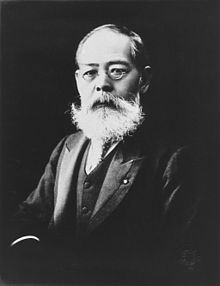|
Aoki Shūzō
Viscount Aoki Shūzō (青木 周蔵, 3 March 1844 – 16 February 1914) was a Japanese politician and diplomat who served as foreign minister during the Meiji era.[1] Early life Aoki was born to a samurai family as the son of the domain physician of Chōshū, in what is now part of San'yō-Onoda in Yamaguchi Prefecture. He studied western science and medicine (rangaku) at the domain school Meirinkan in Hagi, and in Nagasaki. He was then sent to Germany by the Chōshū Domain to study western law in 1868. However, while in Germany, his studies ranged over a very wide area, from western medicine, to politics, military science, and economics. From his surviving notes, he studied how to make beer, paper and paper money, carpets and rugs and techniques of western forestry management. CareerAoki returned to Japan after the Meiji Restoration, and entered the Foreign Ministry of the new Meiji government in 1873, as First Secretary to the Japanese legations to Germany, Netherlands and Austria-Hungary. He then served as Vice Foreign Minister in the first Itō administration and Foreign Minister in the first Yamagata administration. Foreign minister (first)While foreign minister, he strove for the revision of the unequal treaties between the Empire of Japan and the various European powers, particularly the extraterritoriality clauses, and expressed concern over the eastern expansion of the Russian Empire into east Asia. Aoki was forced to resign as a consequence of the Ōtsu Incident of 1891, but resumed his post as Foreign Minister under the Matsukata administration. During his time as minister, Viscount Aoki was instrumental in the development of the internal program for Transfers of technology and advice on systems and cultural ways. By the hand of Aoki, over a dozen of specialized western professionals were brought to Japan in 1887, not only at a governmental level but also into the private sector. Amongst these so called "O-yatoi gaikokujin" were prominent figures including W. K. Burton, Ottmar von Mohl, Albert Favre Zanuti, Henry Spencer Palmer, Hermann Ende, Wilhelm Böckmann, Rudolf Dittrich and Ludwig Riess. Ambassador to the United KingdomIn 1894, as ambassador to Great Britain, Aoki worked with Foreign Minister Mutsu Munemitsu towards the revision of the unequal treaties, successfully concluding the Anglo-Japanese Treaty of Commerce and Navigation for Japan in London on 16 July 1894. Foreign minister (second)Returned to his post as foreign minister under the second Yamagata administration, Aoki helped Japan gain recognition as one of the Great Powers by its military support of the European forces during the Boxer Rebellion. Aoki was then appointed to the Privy Council and elevated in title to shishaku (viscount).[2] Ambassador to the United StatesIn 1906, he was appointed ambassador to the United States.[3] In 1908, Aoki protested to President Theodore Roosevelt to stop racial hostility against Japanese immigrants in California, there were anti-Asian groups and bills that discriminated against the Japanese, which included segregation of Japanese children in schools.[4] Californians did not want Japanese immigrants to dominate the state's agricultural economy, as the Japanese bought their own land and refused to work for white Californians. Aoki negotiated with Roosevelt and reached an agreement to restrict passports, deport some Japanese, and withdraw anti-alien bills. Although this did not stop the immigration of the Japanese or future discriminatory legislation, it did reduce diplomatic hostility.[5] Personal life  On 20 April 1877, Aoki married Elisabeth von Rhade (1849–1931) in Bremen. Elisabeth, the daughter of a Prussian aristocrat, was born in Strippow, Pomerania, Prussia, Germany. Together, they had one daughter:
Aoki died of complications following Pneumonia in 1914 at his home in Kōjimachi, Tokyo.[6][7] His grave is at Nasu, Tochigi. His widow died on 5 April 1931 in Munich, Bavaria, Germany. DescendantsThrough his daughter, he was a grandfather of Countess Hissa Elisabeth Natalie Olga Ilsa von Hatzfeldt zu Trachenberg (26 February 1906 – 4 June 1985), who married Count Maria Erwin Joseph Sidonius Benediktus Franziskus von Sales Petrus Friedrich Ignatius Hubertus Johannes von Nepomuk Felix Maurus von Neipperg (a great-grandson of Austrian general Adam Albert von Neipperg) in Munich in 1927. Erwin and Hissa had four children, but now extinct in the male line. Hissa's daughter Countess Maria Hedwig Gabrielle Nathalie Benedicta Lioba Laurentia von Neipperg (born 10 August 1929) married Sir Anthony Williams, the British ambassador to Argentina during the Falkland War. Morihisa Aoki (born 23 November 1938), Japanese ambassador to Peru during the Japanese embassy hostage crisis was his adopted great-grandson. Aoki villaIn 1888 Aoki commissioned an architect and friend from Berlin times, Matsugasaki Tsumunaga, to build him a villa as resort in Nasu highlands. This villa was costly restored in recent years and entered the list of Important Cultural Properties of Japan.[8] Matsugasaki won Aoki as first president of the newly established Society of Japanese Architects in 1888.[9] Awards and decorationsJapanesePeerages and titles
Decorations
Order of precedence
Foreign
See alsoReferences
Further reading
External linksWikimedia Commons has media related to Aoki Shūzō. |
||||||||||||||||||||||||||||||||||||||||||||
